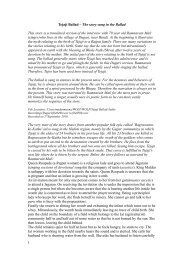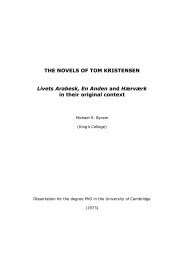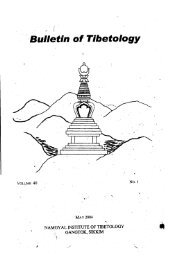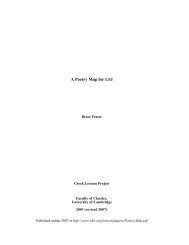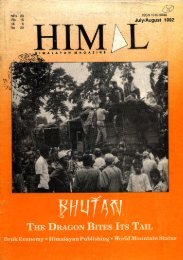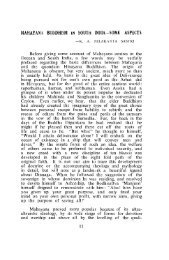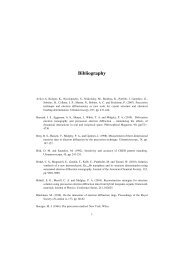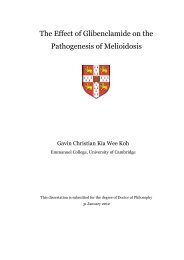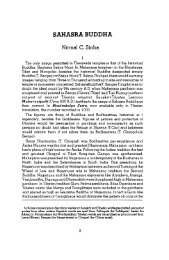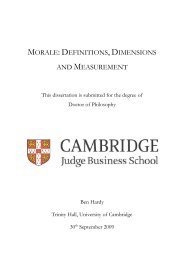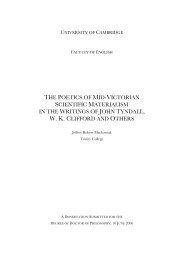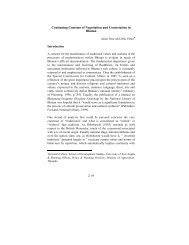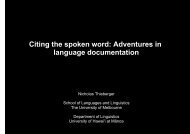The Crusades, the Genoese and the Latin East - DSpace at ...
The Crusades, the Genoese and the Latin East - DSpace at ...
The Crusades, the Genoese and the Latin East - DSpace at ...
Create successful ePaper yourself
Turn your PDF publications into a flip-book with our unique Google optimized e-Paper software.
Fourth Crusade, <strong>the</strong>re was an increase of approxim<strong>at</strong>ely thirty percent in <strong>the</strong> charge per knight<br />
with a horse <strong>and</strong> squires. Some crusaders must have also concluded th<strong>at</strong> it would be cheaper to<br />
share merchants' ships <strong>and</strong> embark separ<strong>at</strong>ely, preferably departing l<strong>at</strong>er than <strong>the</strong> main crusading<br />
wave. Additionally, this increase<br />
in prices spelled trouble for <strong>the</strong> leadership of <strong>the</strong> Fourth Crusade<br />
in 1202, which failed to recruit enough crusaders. It was not until <strong>the</strong> Seventh Crusade th<strong>at</strong><br />
maritime transport<strong>at</strong>ion became more accessible. As Benjamin Kedar showed, in August 1246, on<br />
<strong>the</strong> eve of <strong>the</strong> crusade, travel fees to <strong>the</strong> Middle <strong>East</strong> mounted to £4 tournois per person for a first<br />
class place, £3 <strong>and</strong> £2 tournois for second <strong>and</strong> third places (pl<strong>at</strong>ea) respectively. Unlike <strong>the</strong><br />
situ<strong>at</strong>ion in Genoa in 1190 <strong>the</strong> dem<strong>and</strong> for ships on <strong>the</strong> French Riviera on <strong>the</strong> eve of <strong>the</strong> crusade<br />
in 1248 `exceeded by far <strong>the</strong> facilities available. ' Never<strong>the</strong>less, third-class places remained<br />
rel<strong>at</strong>ively cheap. In Marseilles <strong>the</strong>y mounted to 45s tournois. 124<br />
According to <strong>the</strong> d<strong>at</strong>a in Peter<br />
Spufford's H<strong>and</strong>book of Medieval Exchange, <strong>the</strong> <strong>Genoese</strong> pound was slightly stronger than <strong>the</strong><br />
French tournois in 1248 <strong>and</strong> was, on <strong>the</strong> average, exchanged for 18s. 125<br />
By th<strong>at</strong> time <strong>the</strong> journey<br />
was both much cheaper <strong>and</strong> also much safer, but <strong>the</strong>re were no doubts th<strong>at</strong> a crusade to <strong>the</strong> Holy<br />
L<strong>and</strong> meant a maritime expedition.<br />
<strong>The</strong> sea was a challenge every crusader had to face from <strong>the</strong> time of <strong>the</strong> Third Crusade<br />
onwards. <strong>The</strong>re were new rules for <strong>the</strong> crusading expeditions to <strong>the</strong> Holy L<strong>and</strong> which forced<br />
inherent changes both in <strong>the</strong> conceptualis<strong>at</strong>ion <strong>and</strong> <strong>the</strong> practicalities of <strong>the</strong> crusades. Genoa's<br />
contribution to <strong>the</strong> form<strong>at</strong>ion of <strong>the</strong> crusading movement <strong>at</strong> <strong>the</strong> early stages of <strong>the</strong> Third Crusade<br />
may be compared with <strong>the</strong> contribution th<strong>at</strong> Pope Innocent III made to <strong>the</strong> institutionalis<strong>at</strong>ion of<br />
<strong>the</strong> movement <strong>at</strong> <strong>the</strong> time of <strong>the</strong> Fourth Crusade. He <strong>the</strong>n acknowledged <strong>the</strong> need for even fur<strong>the</strong>r<br />
control over <strong>the</strong> crusaders, from <strong>the</strong> preaching <strong>and</strong> recruitment stages, through regul<strong>at</strong>ing <strong>the</strong><br />
fund-raising <strong>and</strong> tax<strong>at</strong>ion, <strong>and</strong> most importantly <strong>the</strong> fixing of crusading rights <strong>and</strong> formul<strong>at</strong>ion of<br />
indulgences.<br />
<strong>The</strong> economic value of religious sentiment:<br />
<strong>The</strong> <strong>Genoese</strong> involvement in <strong>the</strong> Third Crusade was studied in this chapter through <strong>the</strong><br />
commercial activities of <strong>the</strong> <strong>Genoese</strong> as recorded in <strong>the</strong> notarial cartularies. Drawing on sources<br />
which were not used thus far in <strong>the</strong> historiography of <strong>the</strong> Third Crusade led to many new<br />
conclusions. Ample evidence revealed th<strong>at</strong> <strong>the</strong> <strong>Genoese</strong> were highly committed to <strong>the</strong> crusade.<br />
124 Benjamin Kedar, `<strong>The</strong> Passenger List of a Crusader Ship', p. 271.<br />
125 <strong>The</strong> exchange d<strong>at</strong>a is taken from Peter Spufford, H<strong>and</strong>book of Medieval Exchange (London, 1986), pp.<br />
108-9. <strong>The</strong> d<strong>at</strong>a includes eighteen cases of money exchange between <strong>the</strong> <strong>Genoese</strong> pound to <strong>the</strong> French-<br />
pound tournois recorded between 1248 <strong>and</strong> 1291. In twelve cases <strong>the</strong> <strong>Genoese</strong> pound was purchased for<br />
less than 15s tournois. In 1248, however, <strong>the</strong> <strong>Genoese</strong> pound was slightly stronger. In three out of five<br />
records, <strong>the</strong> <strong>Genoese</strong> pound equalled between 17s <strong>and</strong> 19s tournois. For Spufford's d<strong>at</strong>a online, as<br />
published in <strong>the</strong> H<strong>and</strong>book, see MEMDB on http: //sccOl. rutgers. edu/memdb last accessed on 10 December<br />
2002<br />
46



